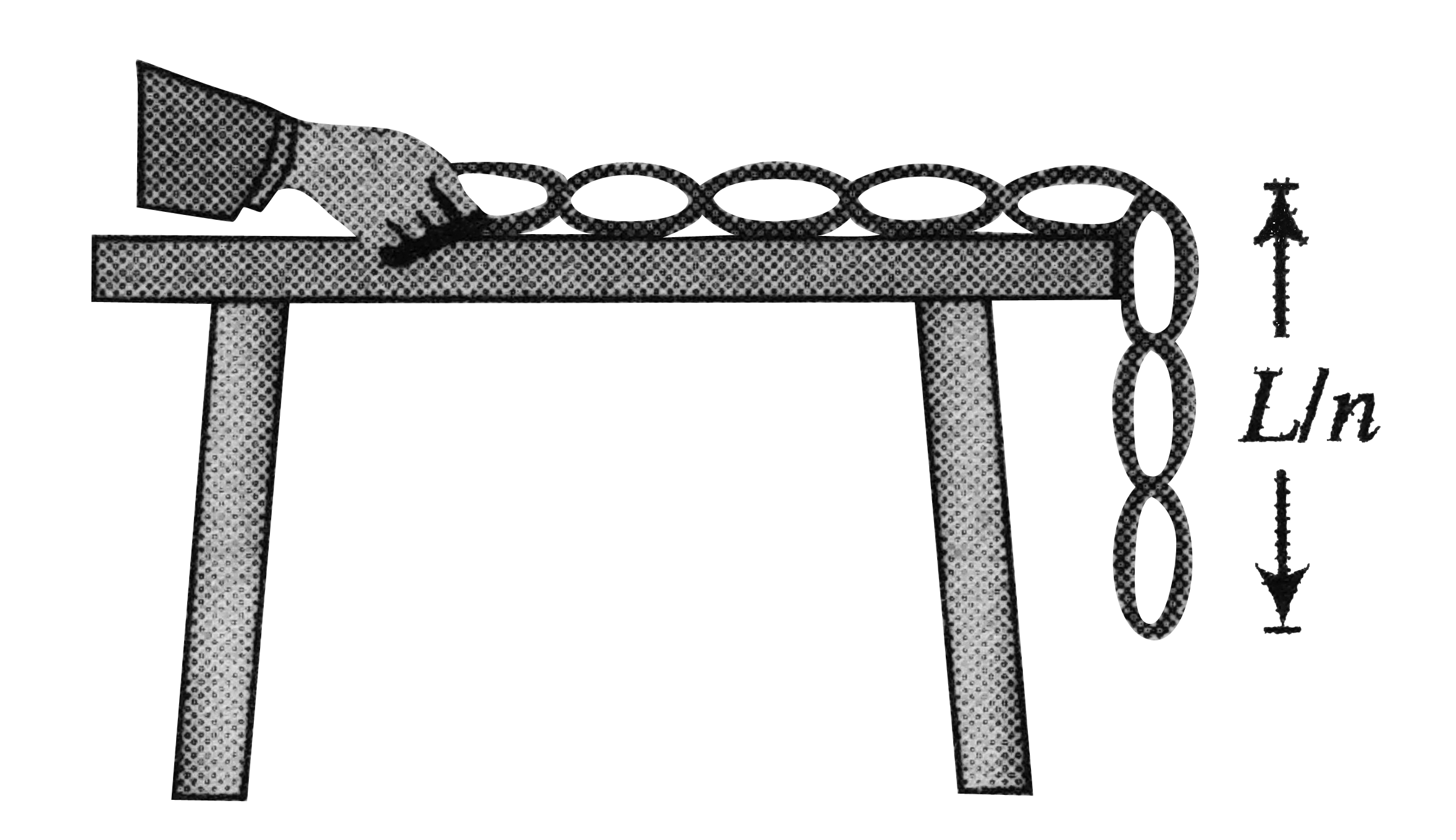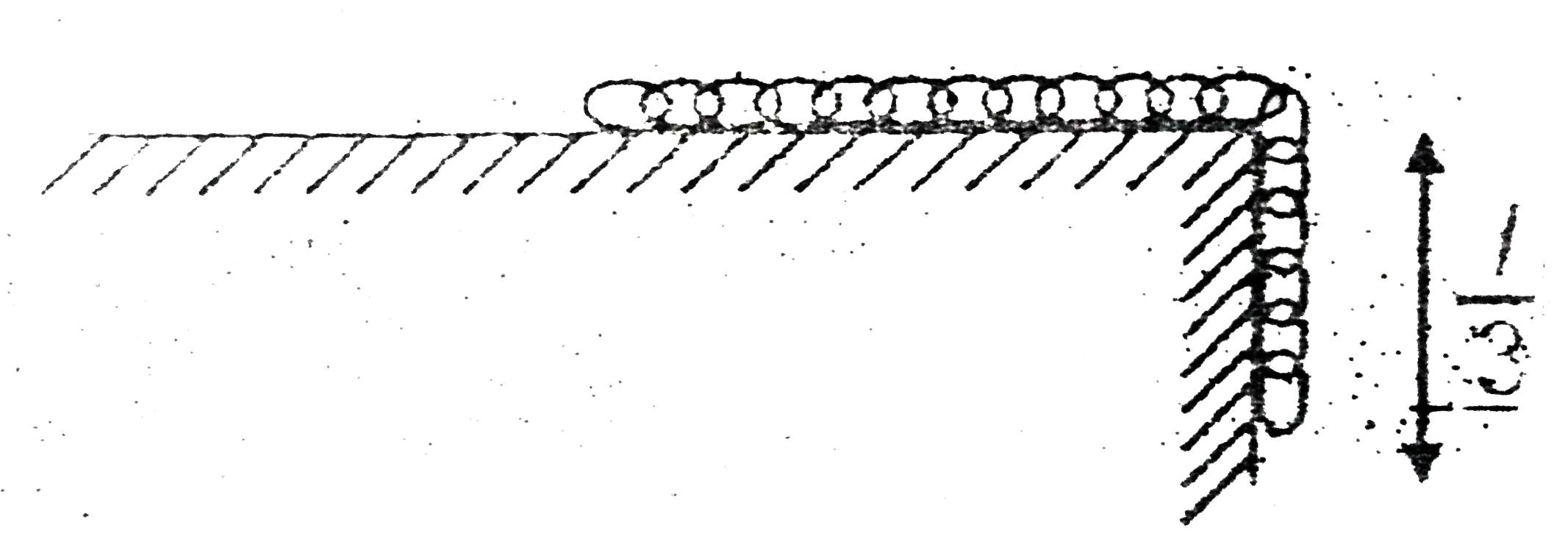A uniform chain of length l and mass m is placed on a smooth table with one-fourth of its length hanging over the edge. The work that has to be done to pull the whole chain back onto the table is :
14mgl
18mgl
116mgl
132mgl
The correct Answer is:D
To solve the problem of calculating the work done to pull the entire chain back onto the table, we will follow these steps:
Step 1: Understand the setup
We have a uniform chain of length l and mass m. One-fourth of the chain's length is hanging over the edge of a smooth table. This means that the length of the chain hanging off the table is l4, and the length on the table is 3l4.
Step 2: Determine the mass of the hanging part
Since the chain is uniform, the mass per unit length is given by:
Mass per unit length=ml
The mass of the hanging part (length l4) is:
mh=ml⋅l4=m4
Step 3: Find the center of mass of the hanging part
The center of mass of the hanging part is located at a distance of l8 below the table (since it hangs halfway down its length of l4).
Step 4: Calculate the change in potential energy
When the entire chain is pulled back onto the table, the potential energy of the hanging part will change. The initial potential energy Ui of the hanging mass (which is at a height of −l8) is given by:
Ui=mh⋅g⋅h=m4⋅g⋅(−l8)=−mgl32
When the chain is fully on the table, its potential energy Uf is zero (as we take the table level as the reference point).
Step 5: Calculate the work done by the external agent
The work done W by the external agent to pull the chain back onto the table is equal to the change in potential energy:
W=Uf−Ui=0−(−mgl32)=mgl32
Conclusion
The work that has to be done to pull the whole chain back onto the table is:
mgl32
---
We have a uniform chain of length l and mass m. One-fourth of the chain's length is hanging over the edge of a smooth table. This means that the length of the chain hanging off the table is l4, and the length on the table is 3l4.
Since the chain is uniform, the mass per unit length is given by:
Mass per unit length=ml
The mass of the hanging part (length l4) is:
mh=ml⋅l4=m4
The center of mass of the hanging part is located at a distance of l8 below the table (since it hangs halfway down its length of l4).
When the entire chain is pulled back onto the table, the potential energy of the hanging part will change. The initial potential energy Ui of the hanging mass (which is at a height of −l8) is given by:
Ui=mh⋅g⋅h=m4⋅g⋅(−l8)=−mgl32
When the chain is fully on the table, its potential energy Uf is zero (as we take the table level as the reference point).
The work done W by the external agent to pull the chain back onto the table is equal to the change in potential energy:
W=Uf−Ui=0−(−mgl32)=mgl32
The work that has to be done to pull the whole chain back onto the table is:
mgl32
Topper's Solved these Questions
- ENERGY & MOMENTUMBOOK - VMC MODULES ENGLISHCHAPTER - ENERGY & MOMENTUMEXERCISE - LEVEL - 2 PARAGRAPH QUESTIONS
2 Videos
- ENERGY & MOMENTUMBOOK - VMC MODULES ENGLISHCHAPTER - ENERGY & MOMENTUMEXERCISE - JEE MAIN (ARCHIVE)
53 Videos
- ENERGY & MOMENTUMBOOK - VMC MODULES ENGLISHCHAPTER - ENERGY & MOMENTUMEXERCISE - Level - 1 PARAGRAPH QUESTIONS
3 Videos
- ELECTROSTATICSBOOK - VMC MODULES ENGLISHCHAPTER - ELECTROSTATICSEXERCISE - JEE Advanced (Archive)
89 Videos
- GASEOUS STATE & THERMODYNAMICSBOOK - VMC MODULES ENGLISHCHAPTER - GASEOUS STATE & THERMODYNAMICSEXERCISE - JEE ADVANCED (ARCHIVE )
111 Videos
Similar Questions
A chain of length L and mass M is held on a frictionless table with (1/n)th of its length hanging over the edge. When the chain is released, find the velocity of chain while leaving the table.

View SolutionA uniform chain of mass m and length l is lying on a horizontal table with one-third of its length hanging over the edge of the table.

What is the speed of the chain, when it just loses contact with the table?
View Solution
Knowledge Check
A uniform chain of length L and mass M is lying on a smooth table and one-third of its length is hanging vertically down over the edge of the table. If g is the acceleration due to gravity, the work required to pull the hanging part on to the table is
AMgLBMgL3CMgL9DMgL18
A uniform chain of mass m and length l is lying on a horizontal table with one-third of its length hanging over the edge of the table.

If a gentle push is given to hanging end, it will start moving down. What is the change in gravitational potential energy of the chain, as it just leaves the table?
View SolutionA uniform chain of mass m and length l is lying on a horizontal table with one-third of its length hanging over the edge of the table.

If the chain is limiting equlibrium, what is the coefficient of friction for the contact between table and chain?
View SolutionA uniform chain of length l is placed on a smooth horizontal table, such that half of its length hangs over one edge. It is releasedfrom rest, the velocity with which it leaves the table is
View SolutionA uniform chain of length l is placed on rough table with length l/n (where n>1) , hanging over the edge. If the chain just begins to slide off the table by itself from this position, the coefficient of friction between the chain and the table is
View SolutionA chain is held on a frictionless table with 1/n th of its length hanging over the edge. If the chain has a length L and a mass M, how much work is required to pull the hanging part back on the table?
View SolutionA uniform chain has a mass M and length L. It is placed on a frictionless table with length l0 hanging over the edge. The chain begins to slide down. Ten, the speed v with which the end slides down from the edge is given by
View SolutionA uniform rope of length l and mass m lies on a smooth horizontal table with its length perpendicular to the edge of the table and a small part of the rope having over the edge. The rope starts sliding from rest under the weight of the over hanging end. The velocity of the rope when the length of the hanging part is . x
View Solution
